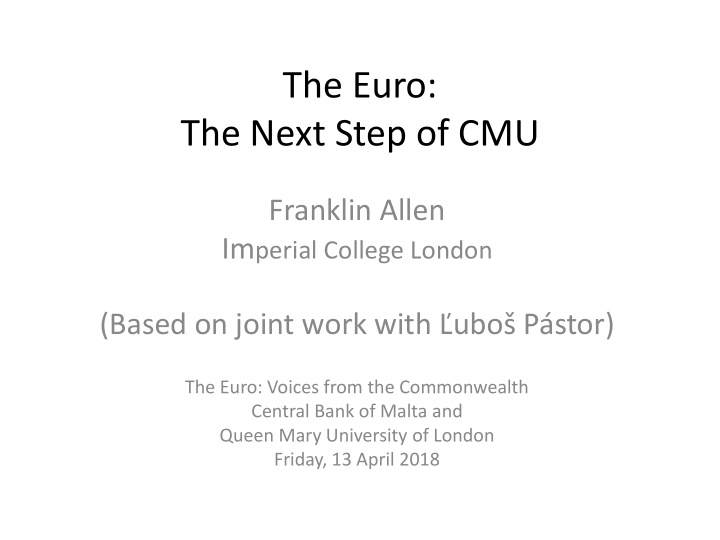



The Euro: The Next Step of CMU Franklin Allen Im perial College London (Based on joint work with Ľuboš Pástor) The Euro: Voices from the Commonwealth Central Bank of Malta and Queen Mary University of London Friday, 13 April 2018
CMU: The Idea • Likely next milestone in European integration – After monetary union (1999), banking union (2014) – Less centralized, more nebulous • Purpose: – Develop and integrate European capital markets – Aim for a single EU market for capital by 2019 • Process: – Gradual, “bottom - up”. No “big bang” legislation. No new EU-level institutions, no single regulatory body. – Removing obstacles to the single market one by one 2
Timeline • Nov 2014: CMU first announced by the European Commission as part of the “Juncker plan” • Feb 2015: Green paper – Principles, objectives, priorities; launch consultations • Sep 2015: Action plan – Simplify prospectus rules; standardize securitization; ease capital requirements for infrastructure investments by insurance companies • Apr 2016: First status report – Good but slow progress on action plan items • Jun 2017: Commission midterm review – 20 of 33 measures in action plan implemented 3
Why CMU? 4
5
6
Benefits of More Developed Markets • Firms: – Alternative to banks as a source of financing – Increased competition will put pressure on banks to perform better – Helps SMEs because of improved securitization of commercial loans • Households: – New investment opportunities – Less home bias – Attractive risk-return tradeoff 7
Benefits of More Developed Markets (cont.) • Society as a whole: – More resilient financial system (more cross-sectional risk-sharing) – Faster growth (improved capital allocation) – Increases venture capital by providing an exit option and this increase allows more innovative firms to be developed 8
The Plan’s Strengths and Weaknesses • The Dark Side of Capital Markets – While they are good for cross-sectional risk sharing they are not good for intertemporal smoothing of risk (Allen and Gale 1997, 2000- Chapter 6) – Long- lived financial institutions such as banks and insurance markets can provide effective intertemporal smoothing provided they are not subject to competition from financial markets 9
The Plan’s Strengths and Weaknesses (cont.) • The Enforcement of Securities Regulations – In the 1930’s the U.S. passed a series of securities regulation acts that set up the Securities and Exchange Commission and prohibited a large set of market abuses such as insider trading, manipulation, and so forth. – Much of Europe only adopted these kinds of regulations in the 1980’s and 1990’s and they are still not effectively enforced in many cases – E.g. Germany 10
The Plan’s Strengths and Weaknesses (cont.) • Bottom-Up vs. Top-Down Approach – Commission plan is a bottom -up approach that identifies and removes obstacles to the CMU – This approach was pushed for by the UK but after Brexit there is much less of a constituency for this – A top- down approach with more involvement by EU institutions seems desirable 11
The Plan’s Strengths and Weaknesses (cont.) • Harmonizing Rules and Standards – Good in the long run but not essential in the short run – What would be good is to clarify what rules apply in what situation – Unequal levels of development probably also not a problem 12
Challenges to European Capital Markets • Financial transactions tax • Low interest rates • Knowledge and culture • Political support 13
Conclusions • On balance, the strengths of better cross - sectional risk sharing and innovation outweigh the disadvantages • Need more ambitious program with greater top-down approach • In particular role of ESMA needs to be expanded 14
Recommend
More recommend